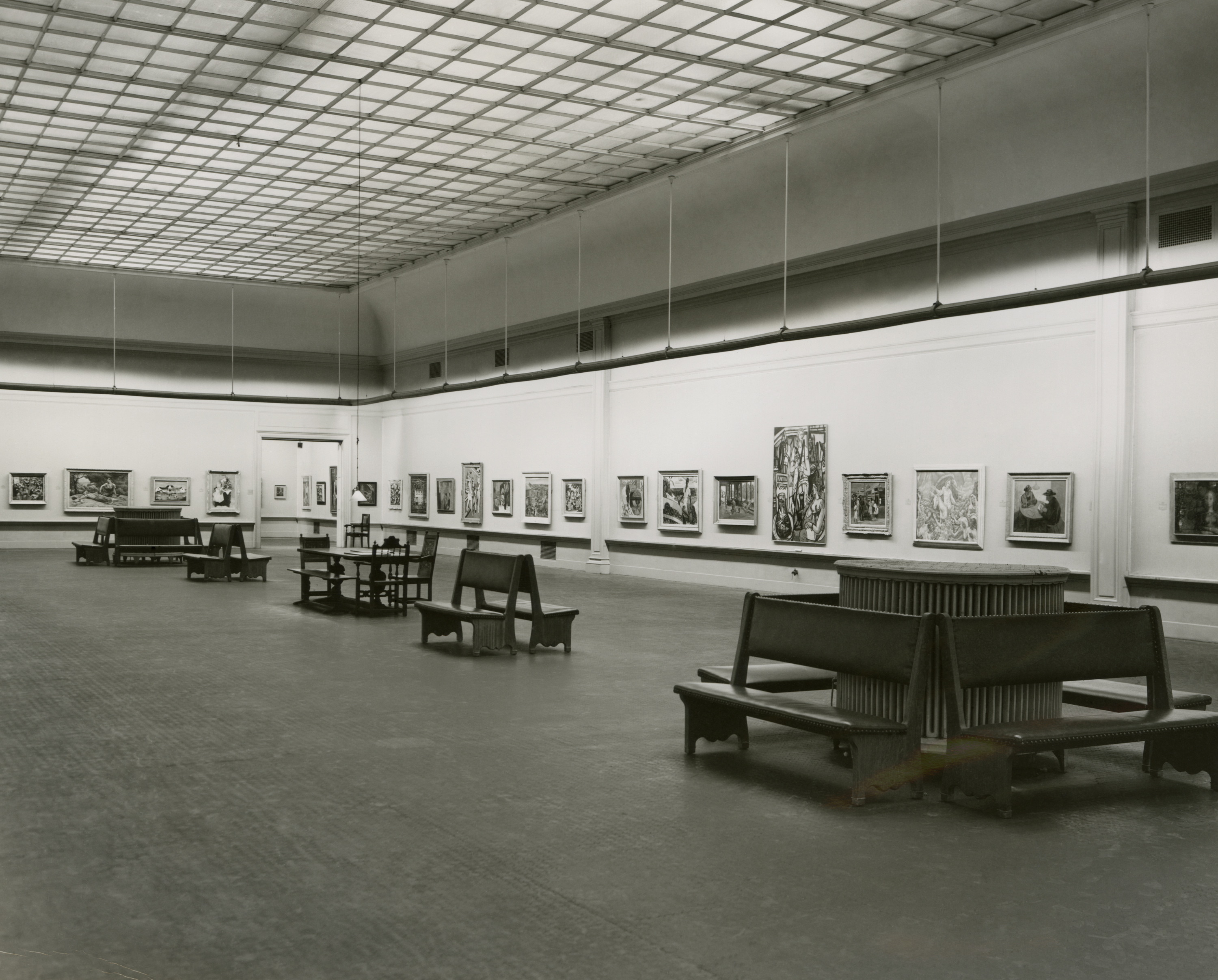An International Legacy
In 1895, Andrew Carnegie, the Scotland-born philanthropist and titan of the steel industry, founded the Carnegie Institute, laying the foundation for the four Carnegie Museums of Pittsburgh that exist today, including Carnegie Museum of Art. To make Pittsburgh “as famous for art as it is now for steel,” Carnegie established an annual survey exhibition of art from which the museum would purchase prizewinners and key works to build its collection.
The exhibition series, which was originally founded in 1896, came to be known as the Carnegie International, the longest-running North American exhibition of international contemporary art. The International was initially staged as an annual exhibition and held every fall until the second half of the 20th century. The early exhibitions featured paintings predominantly by leading American and Western European artists.
In 1952, the event took the title of Pittsburgh International Exhibition, with “contemporary” added in 1955 and “sculpture” in 1958. The title Pittsburgh International Exhibition of Contemporary Paintings and Sculpture remained until the 1970s when it was renamed the “International Series,” showing a spotlight on a single artist in 1977 and multiple artists in 1979.
In 1982, the International reappeared under its triennial survey format as the Carnegie International and has been mounted every three to five years since to present an overview of how art and artists respond to the critical questions of our time through new commissions, existing works, and projects by established and emerging artists working locally, domestically, and internationally.
Since the first Carnegie International, the museum has acquired hundreds of works of art that have appeared in the exhibition series, including works by Josef Albers, Dara Birnbaum, Louise Bourgeois, Mary Cassatt, Nicole Eisenman, Isa Genzken, Dan Graham, Winslow Homer, Edward Hopper, Mike Kelley, Ellsworth Kelly, Louise Lawler, Agnes Martin, Julie Mehretu, Joan Miró, Bruce Nauman, Chris Ofili, On Kawara, Sigmar Polke, Auguste Rodin, Doris Salcedo, John Singer Sargent, Hiroshi Sugimoto, James Abbott McNeill Whistler, and Lynette Yiadom-Boakye.
Current prizes awarded to Carnegie International artists include the Carnegie Prize for outstanding achievement in the exhibition in the context of a lifetime of work and the Fine Prize for an emerging artist in the exhibition.
Timeline
1896–1921
The museum’s first director, John W. Beatty, selected the first International in 1896, with following presentations organized through a group of foreign advisory committees and a jury composed of artists, helping to grow the collection with superior paintings by American artists such as James Abbott McNeill Whistler and Henry Ossawa Tanner as well as distinguished European artists including Alfred Sisley and Camille Pissarro.
1922–1950
The museum’s second director, Homer Saint-Gaudens, focused the International on representation of current art movements prominent from the 1920s through to the 1940s. From 1940 until 1949, the show featured paintings, primarily by American artists with some exceptions, due to World War II and its aftermath in Europe. Shows were mounted by the museum’s assistant director John O’Connor while Saint-Gaudens was in the military.
Saint-Gaudens instituted the display of works by country during these years and also introduced the Popular Prize, voted upon by the public, in 1924, that continued until 1955.
1951–1962
By the 1950s, the museum was poised for reinvention under the leadership of director Gordon Bailey Washburn, who, with the support of Pittsburgh collector G. David Thompson, revitalized the International as a leading exhibition of the world’s most adventurous art of the postwar period.
Washburn maintained his predecessor’s use of foreign advisors but dropped nationality as the International’s organizing structure. From 1958 onwards, Washburn was also instrumental in positioning sculpture as a prominent focus of the exhibition.
1963–1969
The 1964 and 1967 Internationals were organized by the museum’s fourth director, Gustave von Groschwitz, in consultation with seven national correspondents based in Europe, who he referred to as “informal co-jurors.”
Von Groschwitz returned to a nationality-based display structure and did away with numbered prizes, opting for six equal awards and several purchase prizes.
1970–1979
The museum’s fifth director, Leon Arkus, organized his first exhibition in 1970, which featured 267 objects by over 101 artists. This year was also marked by Arkus’s elimination of prizes.
Arkus shifted to a featured-artist exhibition format in 1977 (with Pierre Alechinsky) and 1979 (with Eduardo Chillida and Willem de Kooning) to deepen the museum’s commitment to scholarship around modern masters.
1982–1985
John R. Lane was appointed director in 1980. Lane hired Gene Baro to organize the first International under his directorship in 1982. In 1985, Lane co-curated the International with John Caldwell.
1988–2008
Work on the 1988 show began with Lane and Caldwell as co-curators shortly after the 1985 Carnegie International ended. The 1988 Carnegie International was curated and organized by Caldwell, with Phillip M. Johnston supporting in his role as acting director (appointed in 1987 and officially stepped into the role in 1988).
The Carnegie International 1991 was co-curated by Lynne Cooke and Mark Francis, and Carnegie International 1995 was curated by Richard Armstrong. Johnston remained the director during these years.
Carnegie International 1999/2000 was curated by Madeleine Grynsztejn; the 2004-5 Carnegie International was curated by Laura Hoptman; and Life on Mars, the 2008 Carnegie International was curated by Douglas Fogle. Richard Armstrong was established as director of the museum in 1996.
2013–2019
Following Armstrong’s departure in 2008, and under the new leadership of Lynn Zelevansky, who assumed her role as director of Carnegie Museum of Art in 2009, the 2013 Carnegie International was presented by a curatorial team encompassing Daniel Baumann, Dan Byers, and Tina Kukielski. Pittsburgh native Ingrid Schaffner curated Carnegie International, 57th Edition, 2018, at the invitation of Zelevansky.
2022–Beyond
The 58th Carnegie International, taking place from September 24, 2022 until April 2, 2023, is curated by Sohrab Mohebbi. The 58th Carnegie International will mark the first edition under the directorship of Eric Crosby, the Henry J. Heinz II Director of Carnegie Museum of Art, who assumed the role in 2020.
